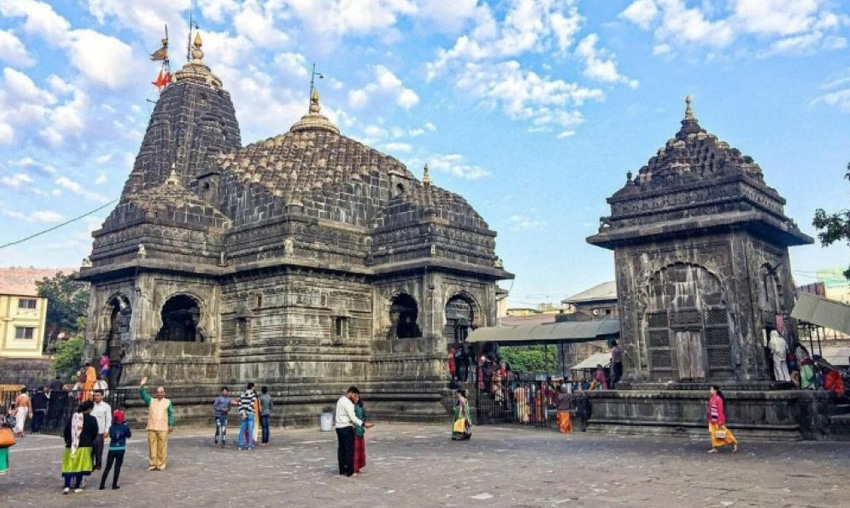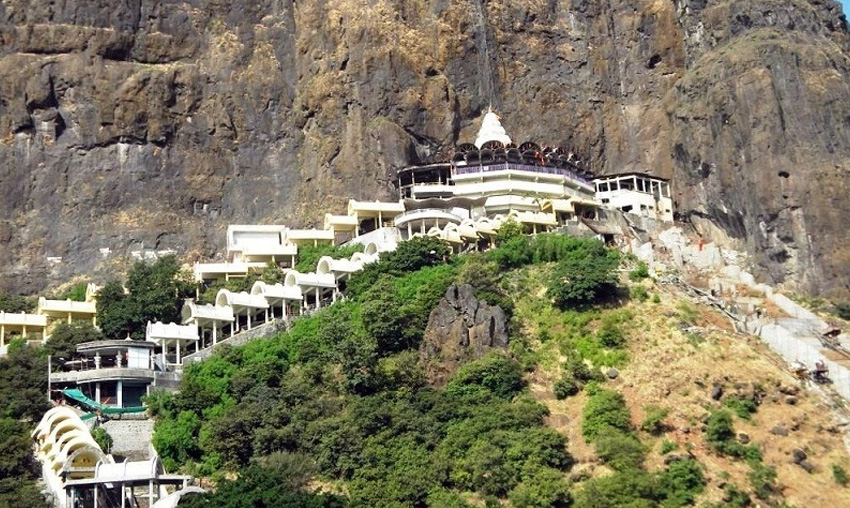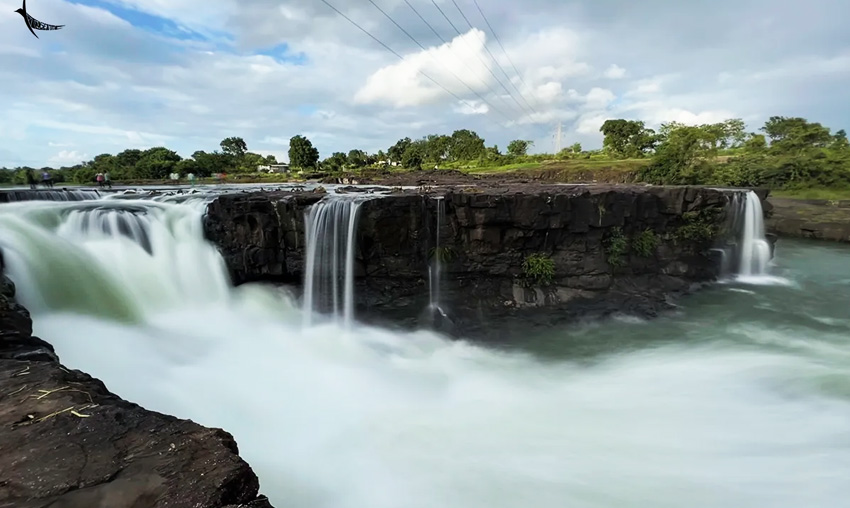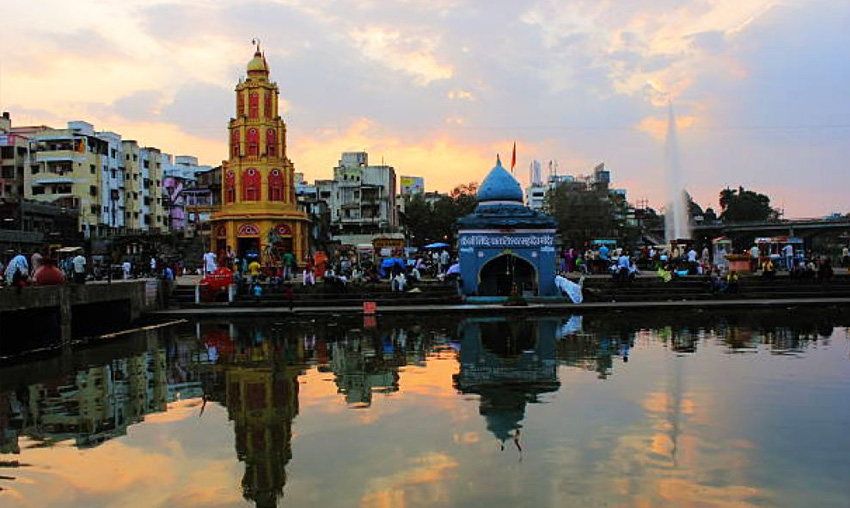Trimbakeshwar Jyotirling Mandir, Nashik Timings, History
One of India’s twelve Jyotirlingas is Trimbakeshwar Temple. This Shaiva temple is situated at the base of the Brahmagiri Hills in Trimbak, 28 kilometers from Nashik city. The temple was built in the 18th century by Peshwa Nana Saheb, the Maratha king, and is referenced in the potent Mrityunjaya Mantra, which grants longevity and immortality.
The temple’s grounds, which feature classical architecture, also mention the Kusavarta or Kunda, which is supposedly the river Godavari’s source. The Jyotirlinga’s three faces, which stand for Lord Brahma, Lord Vishnu, and Lord Rudra, are its most intriguing feature. The temple’s central area, or “garbhgriha,” is only accessible to male devotees. Wearing a silk dhoti or a sovala is required here. If devotees want to take part in the Abhishekam, they must reserve pandits.
History Behind the Triambakeshwar Jyotirling Mandir
One of the twelve well-known, independent temples, Trimbakeshwar Temple has a mythical beginning and is connected to the epic saga of Shiva. Vishnu, the Hindu God of preservation, and Brahma, the Hindu God of creation, argued so bitterly about who was superior that Lord Shiva had to step in, according to the Shiva Purana. In order to test them, Lord Shiva created Jyotirlinga, a massive, endless pillar of light that pierced all three worlds.
In order to determine the origin of the light, Brahma and Vishnu parted ways. In order to prove his dominance over the world, Brahma made up the story of discovering the end of light, and Vishnu admitted defeat. Lord Shiva, who manifested as the second pillar of light, was enraged by Brahma’s lies and punished him. Lord Shiva cursed Brahma, stating that Vishnu would continue to be worshipped until the end of eternity, while Brahma would no longer be worshipped in the mortal world.
Shiva manifested as a fiery column of light at these shrines, and the Jyotirlinga is therefore a partless reality. Only 12 of the 64 jyotirlingas—which were thought to exist—are regarded as sacred and auspicious, as each site symbolizes a different manifestation of Lord Shiva. Since Lord Shiva is considered the limitless, formless, and absolute Brahman and the primordial soul of the universe, the Jyotirlinga site represents his infinite nature.
The Birth of the Triambakeshwar Jyotirling Mandir
Trimbak was thought to be the home of Gautam Rishi and his wife, Ahilya, and was considered the land of rishis. Gautam Rishi prayed to the God of Rain for some rain when the area was hit by a severe drought. Lord Varuna was pleased with his prayers and showered Trimbak with rain for several days. It enabled Gautam Rishi to plant crops and provide food for an increasing number of guests at his Ashram. It only strengthened Gautam Rishi’s punyas.
He once unintentionally killed an innocent cow with his dharba while out in the fields. The cow was Parvati’s friend Jaya, who had assumed the shape of a cow. When other rishis learned of the horrible crime, they refused to use his Ashram. Gautam Rishi begged them to show him the correct way so that he could atone for his sins.
According to the Rishis, he should ask Lord Shiva to release the Ganges, and bathing in the Ganges would atone for all of his sins. Gautam Rishi then spent more than a millennium in penance at the top of the Brahmagiri hills. His prayers were accepted by Lord Shiva, who then asked the Ganga to flow in order to atone for his sins. Ganga, however, appeared to have a different idea. Then, on the summit of Bhramagiri, Shiva danced Tandav Nritya and dashed his jata. The Ganga begins to flow out of fear, and Gautam Rishi could bathe to atone for all of his transgressions.
One of the twelve Jyotirlingas’ unique lingams is housed at the bustling Triambakeshwar Jyotirling Mandir. However, the lingam that represents the deteriorating state of human society has been eroded as a result of excessive water use.
Locals have many amazing tales about the Triambakeshwar Jyotirling Mandir. The temple’s three-faced lingam, which represents Lord Vishnu, Lord Brahma, and Lord Rudra, is one of its distinctive features. A jeweled crown is placed over the Gold Mask of Tridev, covering the three-faced lingam. Emeralds, diamonds, and other valuable stones adorn the crown. The crown is thought to have originated during the Pandavas’ time.
Coincidentally, the prime minister wagered on whether or not the stone encircling the Jyotirlinga is hollow. He was devastated to learn that the stone was hollow, and as a result of losing the wager, he constructed this amazing temple out of it. The famous Nassak Diamond, which the British stole during the Third Anglo-Maratha War, was also owned by the Shiva deity.
The Kumbh Mela is yet another important and well-known festival. Held every 12 years, it is one of the biggest religious gatherings in the world. Millions of pilgrims and enthusiasts flock to the festival to dip in the Godavari for a sacred experience. In 2015, the most recent Kumbh Mela took place.
Devotees believe that Lord Shiva and Goddess Parvati vowed the sacred matrimonial unity on this night, making Mahashivratri, which is celebrated in February or March, a unique day. Devotees continue the tradition today by fasting and singing praises all day and all night.
Architectural Significance Triambakeshwar Jyotirling Mandir
The eighth Jyotirlinga is thought to be the Triambakeshwar Jyotirling Mandir. The architecture of the entire temple is elevated by the use of only black stones. The temple, which has a large courtyard as well, was constructed in the Nagara style during the 18th century. The temple is situated on the Shikhara, a raised platform, and has a lotus-shaped stone plate carved into it. The innermost section of the temple is called the Garbagriha, and the temple deity is protected by the elevated walls. The Garbagriha has three entrances and a hall with a mandap in front of it.
Hindu figures, deities, flowers, people, and animals are depicted in designs on the temple’s walls and pillars. The Trimbakeshwar Temple’s captivating architecture is elaborate and reflects the rich culture of the era. Additionally, this temple features a high-aligned mirror that allows devotees to glimpse the deity’s reflection.
Poojas and Ceremonies at Triambakeshwar Jyotirling Mandir
Kaal Sarp Pooja: Those who are struggling because of their cosmic positions between Ketu and Rahu can perform the Kaal Sarp Pooja. This ritual, which centers on worshiping the Naag, involves offering Lord Shiva a ton of ghee, milk, sugar, honey, and other items.
Narayan Nagbali Pooja: This ritual, known as Pitru-Dosh or Narayan Nagbali Pooja, is performed at the Triambakeshwar Jyotirling Mandir with the intention of removing any ancestral curse that may be lingering in the family. It’s also said that this incident makes it easier to win the Naag’s forgiveness.
Tripindi Shradha Pooja: The purpose of Tripindi Shradha Pooja is to pray for all departed souls and is thought to atone for sins.
The Mahamrityunjaya Pooja: The Mahamrityunjaya Pooja is performed only between the hours of 5:00 and 9:00 in the morning with the intention of praying for a long and healthy life.
The Rudrabhishek: The Panchamrit—milk, honey, ghee, sugar, and curd—is used in the Rudrabhishek-Rudraabhishek ritual.
The Laghu Rudrabhishek: The Rudrabhishek of Laghu It is said that this Abhishek pooja will fix all of your financial and health problems. It is a cosmic disinclination of some kind.
Among the nine Nath Gurus who took Shri Saint Dnyaneshwar as a disciple was Shri Gahininath. He is also recognized as Varkari Sampradaya’s founder. In order to spread the teachings of the Bhagavad Gita to the general public, Saint Dnyaneshwar wrote commentary on it in the Prakrut language, known as “Dnyaneshwari,” at the recommendation of his Guru. At the age of 24, he had taken Sanjivan Samadhi to the temple of Trimbakeshwar.
Nearby Attractions Around Trimbakeshwar Shiva Temple
With its heavenly aura and spiritual significance, Trimbakeshwar Jyotirling Mandir is the main destination for pilgrims from all over the world. This holy location is surrounded by a number of attractions that enhance the region’s appeal and provide tourists with a diverse range of opportunities for spiritual exploration, historical significance, and scenic beauty.
Brahmagiri Hill
The Triambakeshwar Jyotirling Mandir, which is tucked away at the foot of Brahmagiri Hill, offers a breathtaking view of this holy peak. In Hindu mythology, Brahmagiri is regarded as a divine location that can atone for sins just by looking at it. The Godavari River originates on the hill as well. Visitors are rewarded with stunning views and the spiritual significance of the river’s origin after ascending its 700 steps, which takes roughly four to five hours. According to legend, the holy Ganga flows from Brahmagiri in three directions: eastward as the Godavari, southward as Varna, and westward as the Ganga, which meets at Chakra Tirtha.
Kushavarta Kund
Kushavarta Kund, a sacred site with its own fascinating history, is close to the temple. The location is strongly linked to Sage Gautama, who atoned for a sin by performing penance here, and is thought to purify those who bathe in its waters. The kund is a spiritually enlightening visit because it is surrounded by other temples, including Kusheshwar Mahadev and Chintamani Ganesh Ji.
Anjaneri Hills
Anjaneri Hills, the birthplace of Lord Hanuman, combine natural beauty with religious significance. Visitors can enjoy breathtaking views and a strong sense of connection to Hindu mythology during the daring and picturesque trek to Anjaneri Fort. The walk takes about an hour, and the fort and its surroundings provide an energizing experience.
Shree Nivruttinath Maharaj Samadhi Temple
This temple honoring Saint Nivruttinath Maharaj is located in Trimbakeshwar. The temple is well known for its yearly samadhi ceremony, which attracts devotees who take part in the rites and take in the lively festivities. An important occasion in Nashik, the festival is enthusiastically celebrated here.
Shree Swami Samarth Gurupeeth
This site, which is devoted to Swami Samarth and provides a distinctive spiritual experience, is situated in Trimbakeshwar. In addition to exploring the sub-temples, visitors can take in the tranquil surroundings and learn about Ayurvedic techniques. The temple offers a full range of services, from cozy amenities to spiritual instruction.
Saptashrungi Mata Mandir
This temple, one of the 52 Shakti Peethas in India, is located in Vani village, approximately 106 kilometers from Trimbakeshwar. The self-manifested idol at Saptashrungi Devi Temple is a major pilgrimage site that draws thousands of devotees, particularly during Navratri and Chaitra Utsav.
Kedareshwar Temple
Lord Kedareshwar, a manifestation of Shiva, is the object of devotion at this temple. Because of the myth of Lord Shiva rescuing Sage Gautama from sin, it has great meaning. The temple is a noteworthy location for people looking for blessings and divine energy because of its impressive architecture and spiritual atmosphere.
Triambakeshwar Jyotirling Mandir Darshan Pass
VIP Darshan Pass: A VIP Darshan Pass can be purchased at the temple’s main gate for a quicker and more convenient experience. The VIP Darshan Pass, which costs ₹200, enables a more expedited and comfortable visit.
Free Darshan: Depending on the crowd and circumstances, the wait time for the free darshan option may be longer, ranging from one to two hours.
Although the VIP pass guarantees a more efficient visit, both options provide an opportunity to take in the divine atmosphere of the Trimbakeshwar Temple.
Timings And Entry of Triambakeshwar Jyotirling Mandir
Devotees can visit the temple daily between 5:30 AM and 9:00 PM. During festivals and events, special timings are observed, with extended hours according to the occasion. For exact information, it is best to check with the temple authorities as the timings may change during auspicious occasions.
Timings : 05:30 AM – 09:00 PM
Time Required : 1 – 2 hours
Entry Fee : Free
VIP Entry: INR 200
Pooja Costs : Prior booking of pandits for various ceremonies would begin with a fee of at least INR 2000 per person.
How To Reach Triambakeshwar Jyotirling Mandir
How to get to Trimbakeshwar from Nashik, another well-known Maharashtra city, is one of the most frequent questions asked by tourists. Let’s examine the different modes of transportation and crucial information for a smooth trip. One of the twelve Jyotirlingas and a popular pilgrimage site in Maharashtra is the Trimbakeshwar Shiva Temple in Trimbak, Nashik. Travelers frequently look for the easiest ways to get to this revered temple, which is about 28 kilometers from Nashik.
Nearby Cities:
Shirdi: 116 km
Thane: 163.2 km
Pune: 240.5 km
Aurangabad: 224 km
Mumbai: 185.7 km



